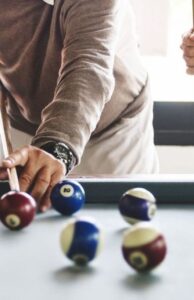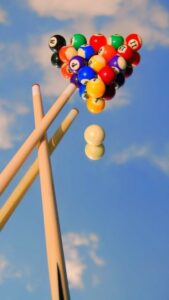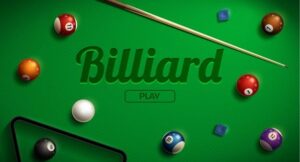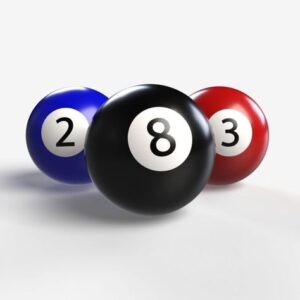As a novice in billiards, you may be eager to quickly grasp the knacks of this sport and showcase your prowess on the billiard table. Don’t worry. SPKI will provide you with comprehensive guidance, from the basics to the advanced levels, to help you quickly get started and improve your skills.
I. Basic Posture and Movements
– Consolidating the standard stance is crucial. Keep your feet shoulder-width apart, lean your body slightly forward, and stabilize your center of gravity on the supporting leg (for those who hold the cue with their right hand, the center of gravity is mostly on the right leg). Such a stance ensures that your body remains stable and your force is smooth when hitting the ball. Imagine yourself as a big tree rooted to the ground, stable and firm, providing a solid foundation for your hitting movements.
– The grip strength of the cue should be moderate. When holding the cue, your fingers should naturally grip it, with the strength being sufficient to control the cue easily. Do not apply excessive force. Gently encircle the cue with your thumb and index finger, and let the other fingers naturally bend and fit. This gives your wrist the space to swing flexibly. This way of gripping the cue allows you to exert force precisely and achieve good control over the cue.
– Building a stable bridge. The commonly used basic bridge is to open your palm, press your five fingers closely against the table, and form a V-shaped groove with your thumb and index finger, in which the cue is stably placed. When encountering special ball shapes, such as when the cue ball is close to the cushion, you can use the cushion bridge. Place your little finger and ring finger on the cushion, and your middle finger and index finger on the table. The cue is placed on the support point formed by your index finger and thumb. A stable bridge is like a solid foundation for the cue, which can greatly improve the accuracy of hitting the ball.

II. Ball Hitting Techniques
– Improving accuracy with center ball hits. Hitting the ball with the center of the cue is a basic technique in billiards. When the cue strikes the center of the cue ball, the cue ball will move forward in a straight line under the force. By repeatedly practicing center ball hits, you can quickly get familiar with the feeling of hitting the ball and master the basic aiming and force application techniques. Every time you hit the ball, focus on the contact point between the cue and the cue ball, as well as the direction and strength of the force, and gradually improve the accuracy of hitting the ball.
– Learning ball positioning with high and low shots. A high shot means hitting the cue ball slightly above the center. The cue ball will generate topspin and continue to roll forward after hitting the target ball. This technique is often used to control the position of the cue ball, enabling the cue ball to get close to the next target ball after the ball is pocketed, creating favorable conditions for the next shot. A low shot means hitting the cue ball slightly below the center. The cue ball will generate backspin and may recoil after hitting the target ball. Learning high and low shots allows you to better control the movement trajectory of the cue ball and enrich your ball hitting strategies.

III. Avoiding Common Mistakes
– Avoid excessive force. Many novices mistakenly think that hitting the ball with great force will lead to a successful shot, but this is not the case. Excessive force not only causes the hitting movement to deform, making the position of the cue ball out of control, but also reduces the accuracy of hitting the ball. When hitting the ball, you should reasonably control the force according to the distance of the ball and the ball shape, and use just the right amount of force to make the ball reach the desired position. For example, when hitting a close ball, a gentle push is enough; when hitting a far ball, increase the force appropriately.
– Overcoming aiming errors. Aiming is a key part of hitting the ball, but novices often fall into aiming errors. Aiming is not just about staring at the target ball. You also need to pay attention to the contact point between the cue ball and the target ball, as well as the ball hitting route. You can imagine a virtual straight line from the center of the cue ball to the contact point of the target ball and then to the pocket. When hitting the ball, let the cue exert force along this straight line, which can significantly increase the probability of pocketing the ball.

IV. Recommended Practice Methods
– Fixed-point practice to improve accuracy. Set several fixed hitting points on the billiard table and repeatedly practice hitting the cue ball from different angles to make it accurately hit the target ball. This fixed-point practice can effectively improve your aiming accuracy and ball hitting stability, allowing you to gradually form muscle memory and be more proficient in actual ball hitting.
– Multi-ball practice to enhance feel. Arrange multiple target balls and conduct continuous ball hitting practice. Multi-ball practice can exercise your concentration and reaction ability, enabling you to quickly judge and accurately hit the ball in different ball shapes and hitting positions. At the same time, during the continuous ball hitting process, you can better master the position of the cue ball and create favorable conditions for the next shot.

As long as you follow these key points, practice carefully, and continuously accumulate experience, you can quickly advance in the field of billiards. You can also use a good billiard table during practice. Spike Billiard Table Manufacturer has 23 years of production and design experience in the billiard industry. Our billiard tables meet international standards and reach the competition level. They are sold both at home and abroad and have received unanimous praise from customers. If you encounter any problems during the practice process or have new ideas, you are welcome to communicate with me at any time. Let’s make progress together in the world of billiards. https://www.tiktok.com/@spk.billiard?_t=8qRRRnXP4N8&_r=1
